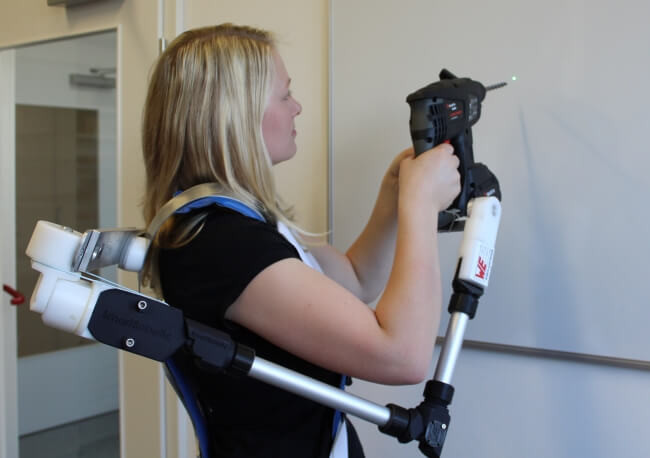Exoskeleton Project Successfully Examines ‘Intelligent’ Arm-Hand Orthosis
| 06-03-2020 | By Nnamdi Anyadike
Although industrial robots today are managing to successfully relieve workers of the burden of carrying heavy loads, there has been less progress for people who work in certain more ‘hands on’ occupations, such as the care sector. Back complaints are one of the most common causes of inability to work in care with carpal tunnel syndrome and epicondylitis of the elbow (‘tennis elbow’) all on the rise. The main cause of these conditions is repetitive movements. Exoskeletons, which support the wearer’s movements, are seen as providing an invaluable service in injury prevention. Key players in this market include: ATOUN Inc., BIONIK, CYBERDYNE, INC., Ekso Bionics, Honda Motor Co., Ltd., ReWalk Robotics, Rex Bionics Ltd., Sarcos Corp., Technaid, SL., and U.S. Bionics, Inc.
Würth Elektronik Circuit Board Technology Concludes ‘PowerGrasp’ Project
In order to work exoskeletons or assistance robots require a human-machine interface to interact with humans in the form of a ‘soft sensor’ system. And improvements to these interface systems is ongoing in a number of institutions. In Germany, after three years of research the results of a landmark ‘exoskeleton’ project concluded by Würth Elektronik Circuit Board Technology (CBT) are now available. The ‘PowerGrasp’ project successfully examined ‘intelligent’ arm-hand orthosis – an area that is likely to have major implications for industrial robots. PowerGrasp, which was funded by the Federal Ministry of Education and Research (BMBF), began in 2015 under the leadership of Würth Elektronik Circuit Board Technology (CBT) with the contribution of various university and non-university research institutions. The network coordinators were: Würth Elektronik CBT and the Fraunhofer Institute for Production Systems and Construction Technology IPK. Partners included: the Evangelische Hochschule Nürnberg, the Schunk GmbH & Co. KG, the Textile Research Institute Thuringia-Vogtland e. V. (TITV), Berlin University of the Arts (UdK), warmX GmbH, the Rehabilitation Center Lübben and Volkswagen AG (associated partner) as well as other participants from industry and trades.

Dr Jan Kostelnik, Head of Research and Development at Würth Elektronik CBT explained, "The aim of this project was to develop an active orthosis with soft mechanics for the arm and hand in order to support workers of all ages in manual, musculoskeletal and stressful activities. As technology partner, Würth Elektronik CBT was responsible for the technical implementation of the sensors as well as the development and manufacture of electronics.” In the course of the project, the researchers explored modern textiles in which electronic components as well as power-boosting pneumatic drive elements, i.e. air-powered, can be installed. The result is a soft robotic orthosis which can be worn. Additional work dealt with smart materials to record muscle activity. The project found that with the help of algorithms, muscle fatigue can be identified and the support adjusted if necessary.
Würth Elektronik CBT’s stretchable biocompatible ‘TWINflex Stretch’ printed circuit boards (PCBs), which utilised a network of sensors, was key to the project’s success. ‘SmartSensX’ sensor nodes captured the human position with MEMS inertial sensors and provided the data via wireless or wired interfaces. In principle, the technology will also be able to support the elderly and people with disabilities. In the long term, the project partners are working to develop a complete exoskeleton to support all movements. During the year, the demonstrators will be presented to the public at various fairs and conferences.
Exoskeleton Assistance for Cerebral Palsy Sufferers
A robotic exoskeleton that provides resistance while walking could be used to strengthen leg muscles, allowing for greater ease of walking in people with cerebral palsy (CP), a pilot study suggests. Further work will be needed. The study, ‘Adaptive Ankle Resistance from a Wearable Robotic Device to Improve Muscle Recruitment in Cerebral Palsy’, points to the possibility of sufferers from CP being able to walk better by wearing a robotic device. Cerebral Palsy News Today reported, “People with CP often have weak and poorly coordinated plantar flexors...These muscles contribute as much as half of the force that is generated while walking.” Through a combination of sensors, the exoskeleton that can be worn round the legs track the gait of the person wearing it, and provide a modest amount of resistance while the person is stepping forward.
‘Exo-suits’ Finding Their Niche
Meanwhile, an even more ground breaking development than the elaborate, hard-bodied exoskeleton, is the soft, garment-like, easier to wear ‘Exo-suit’. Last year, a US team led by Harvard University’s Wyss Institute for Biologically Inspired Engineering published details of its multipurpose “hip exo-suit” in the journal ‘Science’. Previous exo-suits have been designed for particular purposes, especially medical rehabilitation. But said Conor Walsh, the project leader, “This is the first time a research group has created a wearable robot that can help more than one activity.”
The US military co-funded the Wyss research through the Defense Advanced Research Projects Agency’s Warrior Web programme, which aims to produce exoskeletons that help soldiers to carry heavy weights over long distances. But the researchers envisage future recreational applications of their new hip exo-suit. The exo-suit detects the wearer’s intended gait from motion sensors on the skin of the upper leg. These signals are then processed by an algorithm in an actuator attached to the lower back, which provides appropriately timed assistance to the hip joint and gluteal muscles. Tests showed that users reduced their average metabolic rates by 9.3 per cent when walking and 4 per cent when running, compared with the same activities without the device.
Outlook
A recent study sees the smart exoskeleton market achieving a whopping CAGR of 41.3% from 2018 to 2025, to reach a valuation of $1.9 billion.

